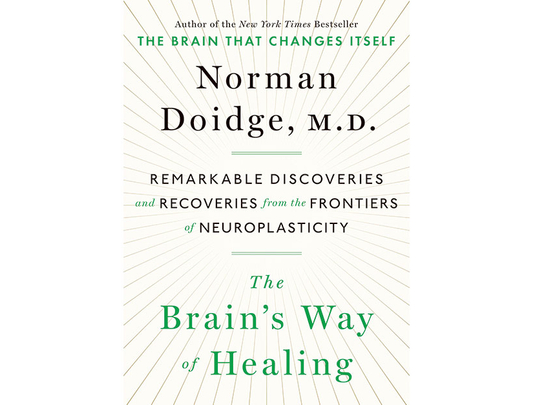
The Brain’s Way of Healing: Stories of Remarkable Recoveries and Discoveries By Norman Doidge, Viking, 432 pages, $22.41
Dr Michael Moskowitz, an American psychiatrist specialising in treating pain, had long been his very own laboratory rat. After breaking his femur jumping from the turret of an army tank, he made an important discovery: the brain could be taught to turn off even screaming pain, once the body had sent the necessary alarm signal.
Years of chronic pain linked to a neck injury sustained in a waterskiing accident meant Moskowitz already knew that neurons can misfire, becoming hypersensitive. The initial cause of pain may have gone, but the injured area still seems to hurt. Once habituated to pain, the smallest thing can set it off. But if repeated bodily experience or movement leads to structural changes, so can mental experience and exercise.
Treatment that involved visualising the affected brain areas when pain struck and imagining them shrinking (engaging in “neuro-stimulation” and creating “competitive plasticity”) cured Moskowitz’s long-standing neck problem.
Having systematised the practice for his patients, he went on to improve the lives of many suffering from a range of chronic pain conditions, from back discomfort to multiple sclerosis.
Norman Doidge, a psychiatrist, psychoanalyst and author of the bestselling book “The Brain that Changes Itself”, says such treatments are neither hypnosis, self-hypnosis nor due to a placebo effect. All of those may have some beneficial impact on certain chronic sufferers, but what is at play is a (re)modelling of the brain, a change in the way its neurons fire.
Important among Moskowitz’s findings and those of many others in the field is the suggestion that, after a short time, the opioid narcotics used for pain treatment cease to work. The plastic brain’s own opioid receptors grow saturated. It produces new ones less sensitive to the medication, rendering the patient more and more dependent on higher and higher doses.
For Moskowitz, weaning the patient away from opioid-induced brain sensitivity is one of the first tasks in a treatment process that engages the patient in relentless mental effort. Moskowitz is one of many practitioners, cutting-edge scientists and patients who figure in this fascinating book. All their stories underline that, well into old age, the body and the senses affect our brain, creating, reactivating or damaging neural fields.
In turn, the brain can act to stimulate, revivify or alter what the body feels, perceives or can do. Stroke or brain tumour sufferers can create new neural circuits to regain language, balance and movement. This is a book of miracles. Against the odds, John Pepper upended all predictions about Parkinson’s disease, the chronic neuro-degenerative disorder with which the South African was diagnosed in 1992, almost two decades after first showing symptoms. Thanks to a taxing regime of walking, in which he observed the process and effectively (re)learnt the way a child might, he weaned himself off medication. By the time Doidge met him, he showed few Parkinsonian symptoms.
He said he was “using a different part of my brain to control an action which was usually controlled by my unconscious”. The physical and mental habits attacked by the disease were bypassed by a self-attentive walking programme. New neural networks were brought in to play to enable the activity.
The French doctor Alfred Tomatis, taught at school by Jean Paul Sartre, went on to study ear, nose and throat medicine. He observed that aircraft factory workers were going deaf in a certain range of their hearing and that deafness caused by jet engines and explosions could lead to motor and psychological problems. Children with ear problems, some of them autistic, often hear undifferentiated noise, so their auditory cortices never develop normally. Tomatis devised a listening system that allowed sufferers to develop differentiated brain maps by training their hearing. One of the troubled young men he helped, Paul Madaule, went on to create a listening therapy — based on music and the mother’s voice — for children with learning difficulties.
According to Doidge, the effects have been extraordinary. There is more: Moshe Feldenkrais, who began his professional life in Marie Curie’s uranium lab, learnt from judo and his own knee problems how to ameliorate serious brain difficulties through mental awareness of movement. David Webber went blind, underwent many operations to restore some of his sight, and finally applied Feldenkrais’s exercise method plus Buddhist meditation — now so popular as a basis for mindfulness therapies that people have talked of a “mindfulness revolution”.
Gradually, with effort, Webber regained his sight. While Doidge lacks Oliver Sacks’s narrative brilliance, his absorbing book brings Sacks to mind. He uses the language of the brain and contemporary neuroplasticity rather more than Sacks. Yet his emphasis points to a tradition of psychosomatic medics and researchers who reported many instances of the mind (consciously or unconsciously) affecting disorders of the body and brain.
With its citing of meditational and eastern iques, the book also tilts into the spiritual. This can sometimes give one pause, as if you suddenly realised you were attending a banquet for mesmerising eccentrics, strange sufferers, and scientist-believers, when you thought you were going out to visit the nearest hi-tech lab.
But why not? Insights into extremes of the human condition and how to ease its pain and ills can come from many places. And if Doidge is right about how we can lower our risk of dementia by 60 per cent, I’m all for the latest neuroplastic miracle treatment.
–Guardian News & Media Ltd
Lisa Appignanesi’s “Trials of Passion: Crimes in the Name of Love and Madness” is published by Virago/Little Brown.








